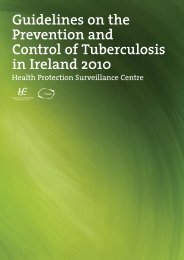Guidelines for the Early Clinical and Public Health Management of ...
Guidelines for the Early Clinical and Public Health Management of ...
Guidelines for the Early Clinical and Public Health Management of ...
Create successful ePaper yourself
Turn your PDF publications into a flip-book with our unique Google optimized e-Paper software.
<strong>Guidelines</strong> <strong>for</strong> <strong>the</strong> <strong>Early</strong> <strong>Clinical</strong> <strong>and</strong> <strong>Public</strong> <strong>Health</strong> <strong>Management</strong> <strong>of</strong> Bacterial Meningitis (including Meningococcal Disease)<br />
Chapter 3: Hospital <strong>Management</strong><br />
Key points<br />
• The development <strong>of</strong> signs suggestive <strong>of</strong> acute sepsis <strong>and</strong>/or meningitis is a medical emergency <strong>and</strong><br />
m<strong>and</strong>ates prompt intervention.<br />
• <strong>Management</strong> priorities differ depending on <strong>the</strong> clinical presentation i.e. that <strong>of</strong> severe sepsis with or<br />
without associated meningitis, or that <strong>of</strong> meningitis.<br />
• If a patient has clinical signs or symptoms suggestive <strong>of</strong> invasive meningococcal disease (meningitis<br />
or septicaemia) <strong>the</strong>y should be given parenteral antibiotics immediately.<br />
• All patients should ideally be placed in isolation in a single room <strong>for</strong> <strong>the</strong> first 24 hours <strong>of</strong> treatment.<br />
• If <strong>the</strong>re are no signs <strong>of</strong> meningeal irritation or meningitis is not suspected, lumbar puncture is not<br />
required on initial assessment.<br />
• Consider lumbar puncture <strong>for</strong> a person in whom meningitis is suspected only if <strong>the</strong>re are no<br />
contraindications (<strong>the</strong> patient is neurologically stable <strong>and</strong> <strong>the</strong>re are no signs <strong>of</strong> increased intracranial<br />
pressure or o<strong>the</strong>r contraindications).<br />
• Treatment should not be delayed while awaiting results <strong>of</strong> diagnostic tests.<br />
• Collect blood samples as soon as possible <strong>for</strong> PCR <strong>and</strong> culture, <strong>and</strong> full blood count.<br />
• If petechiae or frank bleeding is evident, <strong>for</strong>mal coagulation studies should be undertaken.<br />
• The patient should be given chemoprophylaxis when able to take oral medication <strong>and</strong> be<strong>for</strong>e<br />
discharge from hospital, unless <strong>the</strong> disease had already been treated with ceftriaxone.<br />
• The department <strong>of</strong> public health (medical <strong>of</strong>ficer <strong>of</strong> health) should be notified immediately so that a<br />
public health response can be determined.<br />
• Hospitals <strong>and</strong> departments <strong>of</strong> public health should have local protocols <strong>for</strong> dealing with<br />
chemoprophylaxis including out-<strong>of</strong>-hours.<br />
3.1 Introduction<br />
The development <strong>of</strong> signs suggestive <strong>of</strong> acute sepsis <strong>and</strong>/or meningitis is a medical emergency <strong>and</strong> m<strong>and</strong>ates<br />
prompt intervention. <strong>Management</strong> priorities differ depending on <strong>the</strong> clinical presentation i.e. that <strong>of</strong> severe sepsis<br />
with or without associated meningitis, or that <strong>of</strong> meningitis.<br />
<strong>and</strong>/or bacterial meningitis is suspected.<br />
In both scenarios it is imperative that appropriate antimicrobials are given as soon as <strong>the</strong> diagnosis <strong>of</strong><br />
sepsis<br />
Acute meningococcal disease, <strong>the</strong> most common cause <strong>of</strong> life threatening infection in healthy children <strong>and</strong> young<br />
adults, commonly presents as severe sepsis <strong>and</strong>/or meningitis. Rarely, o<strong>the</strong>r <strong>for</strong>ms <strong>of</strong> invasive meningococcal<br />
infection are encountered. The overall mortality rate <strong>for</strong> meningococcal infection is approximately 3-10%, but can<br />
reach as high as 20-40% in severe sepsis/meningitis. In a review <strong>of</strong> 407 children in Irel<strong>and</strong>, with meningococcal<br />
infection who survived to hospital admission between 1995 <strong>and</strong> 2000, <strong>the</strong> overall mortality rate was 3.6-4.8%. 19<br />
From 1999 – 2005, <strong>the</strong> overall case fatality rates <strong>for</strong> meningococcal infection in Irel<strong>and</strong> ranged from 3-5% with<br />
somewhat higher rates observed in adults (7-8%). 20<br />
Despite <strong>the</strong> efficacy <strong>of</strong> <strong>the</strong> MenC vaccine, meningococcal infection remains <strong>the</strong> most common cause <strong>of</strong> bacterial<br />
meningitis in Irel<strong>and</strong>. Serogroup B isolates account <strong>for</strong> <strong>the</strong> overwhelming majority <strong>of</strong> cases now diagnosed in<br />
Irel<strong>and</strong>. The speed with which meningococcal infections are recognized <strong>and</strong> treated is critical to achieving a<br />
-20-

















